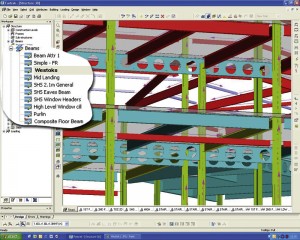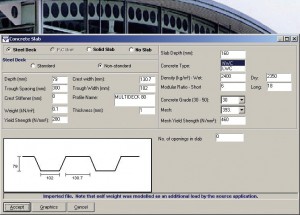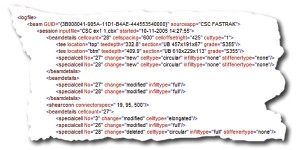Projects and Features
Assuring the Quality of Data Exchange during Structural Design
Common data exchange models are the ideal solution to software integration problems, but what to do when there are none available? The Steel Construction Institute reports on development of a practical solution.
Design software plays a major role in almost every construction supply chain, be it the delivery of modern steel, concrete or composite structure. Therefore, quality assurance of the software is a key issue within the packages themselves, and is accentuated when software integration is involved.
In the context of structural modelling, designers manually enter geometry and loading information into structural design software, which enables them to model and view the structure. They will often refine the optimal size for elements by transferring their initial information into specialist software. This process implies that structural design is increasingly discharged through integration of software packages.
“At its crudest, this involves a round trip of data between different software, with little reconciliation of information when changes occur,” says John Moran, Senior Manager in SCI’s ICT department.
In practice, it is common for designers to make educated guesses at design sizes when a structure is initially modelled, they then improve these ‘guesses’ through sophisticated detail design and improve the initial sizing.
Often software packages supporting the design process are not integrated and different packages are able to represent different levels of detail. Information required to enable the safe operation of a particular structural element may be modelled in one design package and not completely transferred through to another. In consequence, the structural designer is left with uncertainties.
“This part of the supply chain is unsatisfactory in terms of the quality of information transfer,” adds Mr Moran. “Ultimately software developers not only have the responsibility to raise the awareness around quality assurance, but also to provide the means to improve the situation”.
So what is the solution?
Clearly common data exchange models are the ideal solution; if these are not available to software developers then intermediate solutions are essential. For instance, SCI have developed a solution, which extends SCI’s quality scheme to permit the audit of changes in information as a model moves between software packages. This practical approach proved effective when SCI was requested to develop a software package enabling the integration of CSC Fastrak with Westok Cellbeam Automate.
How does Westok/SCI new Cellbeam Automate software work?
- In a CSC Fastrak model, a designer may wish to execute an optimised design in for a cellular form beam
- The beams to be so designed can be identified and data is automatically exported
- Through the CSC to Cellbeam interchange file, beam models can easily be imported into the Cellbeam Automate™ package
- Within Cellbeam Automate™ the designer may set limiting parameters in beam depth and cell opening geometry and request a possible design solution. Cellbeam Automate™ then rapidly arrives at an optimised solution based upon the geometry and loadings initially entered in CSC software. In the process the original model date is altered
- After a solution has been found, the designer may wish to further improve the performance of the selected design. Again, the model data is being changed within Cellbeam Automate™
- The designer may improve the solution over a large number of sessions and every change he makes, is recorded in a log file. The file originally exported from CSC Fastrak ‘knows’ that it has a partner log file generated with Westok Cellbeam Automate™
- The log file is developed in XML so that it is verbose (can easily be understood) and is machine readable
- The designed beam is then returned to the CSC model
- The log file is also returned to the CSC software as a complete quality audit of what changed outside Fastrak
With the new Westok Cellbeam AutomateTM, it is now possible for designers, modelling with CSC’s Building Designer, to export cellular beams to Westok Cellbeam and to take advantage of its refined design capabilities by returning to the parent software the modified export file together with a log file containing the entire change history for the file originally exported to it.
Mike Hawes, Technical Director of Westok Ltd says, “The SCI solution for Westok Cellbeam Automate™ clearly evidences the importance of software integration and quality management. SCI demonstrated the ability to develop and provide a practical and effective solution, which enables designers to define structural schemes in the most optimal and accurate way”
Mr Moran concludes: “Though the new version of Cellbeam Automate™ contributes towards the quality of design within steel supply chain, it does not solve the problem of quality in software; and it merely illustrates our responsibility in supporting software end users.”
With the rapid increase in sophistication of modern packages, together with the need to deliver increasingly complex structures in reduced time and a trend towards software package integration, the importance of quality in software increases and the usual disclaimers are simply no substitute for proper quality management.
About SCI ICT
In recent years, SCI’s ICT department has developed an enviable reputation for the quality and timeliness of its software products. The ICT department constantly aims at providing innovative and quality products in order to meet and exceed its customers’ expectations.
ICT specialises in:
- Developing customised engineering software solutions to empower specialist designers and to support the application of new steel products,
- Information systems and dissemination, through the provision of Internet services including web site design, hosting and management.
- Specialist Consultancy such as the development of e-learning and training systems
- Electronic directory publishing














